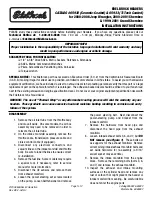
Catalog #70024 & 70025
Brochure No. 63-0182
Page 6 of 6
©2008 Edelbrock Corporation
Rev. 6/08
Ignition Timing and Nitrous
Because we are oxidizing the air/fuel mix going into the engine when nitrous oxide is used, we must pay close attention to the ignition timing
profile. Remember, “nitrous” oxygen is more dense than “atmospheric” oxygen and results in an accelerated burn rate of your fuel.
In anticipation of the quicker burn time, you must retard the timing of the ignition system when using nitrous oxide. The more power we try to
make, the more timing in degrees we must remove from the timing profile. This is not only in total advance but the time in which we bring timing
in (the advance curve).
This is why all nitrous users are so concerned with evidence of detonation. The accelerated burn rate of the air/fuel charge can cause severe
detonation without a “nitrous” ignition strategy. A timing profile that is accelerated and a total timing number retarded will keep you from
experiencing catastrophic engine damage.
The general rule of nitrous ignition timing should be to retard the “Total” advance number approximately 2 degrees for every 50 HP increase when
using nitrous oxide. It is always best to start with your engines best total timing (without nitrous) and reduce total timing from there. Use an initial
timing retard setting that is at least 2-4 degrees more retarded than you expect to be the best setting for your application. All stated timing
adjustments listed in jet maps is where the motor being tested worked best.
Every aspect of the vehicle and engine affects your nitrous systems performance-- vehicle weight, converter, gearing, engine displacement,
cylinder head type, camshaft, compression, manifold and induction type ect.. The exact amount of timing to pull out varies for every combination.
Start conservatively, and put timing back in gradually. On a Nitrous system, even 1 degree change in advance can make a big difference.
When using aftermarket ignition components and/or systems, it would be advisable to contact the manufacturer for information on using their
components with a nitrous system. It is always better to be very conservative in your timing approach and tune towards an optimum timing setting.
Example:
Ignition timing without Nitrous Oxide
38 degrees “total”
100 HP increase from Nitrous Oxide
4 degrees “retard”
Initial safety margin
2 degrees “retard”
Initial timing with Nitrous Oxide
32 degrees “total”
The following test plan, for determining ignition timing, will give you a guide to determine the best timing profile for your vehicle, hopefully avoiding
engine damage during the tuning phase:
1.
Install the nitrous jetting for a selected horsepower increase. Use the 100 horsepower setting to learn the finer points of working with nitrous
oxide. This will keep your margin for error as large as possible.
2.
Estimate the reduced ignition timing that you think will produce best power, based upon the 2° retard per 50 HP increase rule.
3.
Set ignition timing 2°-3° retarded from your best power estimate setting. This is your cushion for error.
4.
Stabilize nitrous bottle pressure at 900 to 950 psi. It is best to select a pressure and keep the pressure to ±¼ psi.
5.
Run your vehicle in a controlled manner (like a ¼ mile drag strip) without the use of nitrous. This is called “on motor”. Note vehicle mph as
a baseline to measure nitrous assisted increases.
6.
Adjust your ignition timing to a nitrous timing setting.
7.
Run your vehicle in the same controlled manner (like a ¼ mile drag strip) with the use of nitrous. Note vehicle mph increase and compare it
to your baseline.
Note:
Listen for any knocking sounds when running the vehicle. Watch your temperature gauges. Continued nitrous use will elevate coolant
temperatures. See Testing Checklist for more testing methodology helpful hints.
Edelbrock Corporation, 2700 California St., Torrance, CA 90503
Tech Line: 1-800-416-8628
E-Mail: [email protected]
























